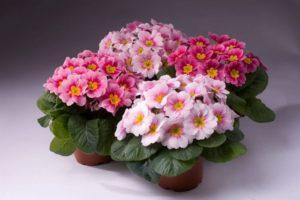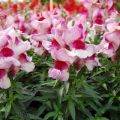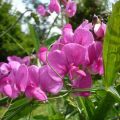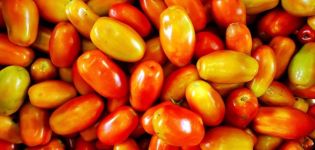Description of the 20 best varieties of perennial scabiosa, growing from seeds
The perennial scabiosa has many advantages. In addition to beautiful colorful flowers, the plant will delight you with its high resistance to low temperatures and drought. Knowing the rules of planting and caring for a flower, it will be possible to achieve lush and long flowering. All varieties and varieties differ in growth characteristics, flowering times, shape and color of inflorescences. It is permissible to plant both seeds and pre-prepared seedlings in open flower beds.
Content
- 1 Description and features
- 2 Kinds
- 3 Popular varieties
- 3.1 Blue Note
- 3.2 Pink mist
- 3.3 Blauer Atlas
- 3.4 Clive greaves
- 3.5 Miss willmott
- 3.6 Nachtfalter
- 3.7 Moerheim blue
- 3.8 Blue moon
- 3.9 Rose cackade
- 3.10 Monarch cockade
- 3.11 Fire king
- 3.12 Icy heart
- 3.13 Blauer Mond
- 3.14 Laheroza
- 3.15 Fairy
- 3.16 Schneebal
- 3.17 House of Isaac
- 3.18 Japanese romance
- 3.19 Butterfly blue
- 3.20 Ritz Blue
- 4 How to plant in open ground
- 5 Growing through seedlings
- 6 Reproduction
- 7 Care
- 8 Collection and storage of seeds
- 9 Diseases and pests
- 10 Use in landscape design
- 11 How is it used in floristry
Description and features
Perennial scabiosa refers to herbaceous or shrub plants. The people call a flower pile, scrofula, rough cornflower, button:
- The stem of the flower is strong, erect or branched. It reaches a height of 1 meter.
- Leaves are oblong, in the form of feathers.
- Inflorescences are located at the very end of the stem, form dense bundles in the form of a ball or hemisphere.
- The strong aroma of scabiosa attracts pollinating insects.
- The fruit is an achene with a bell-shaped shell.
Individual parts of the plant have healing properties. Infusions and decoctions are used in the treatment of headaches or toothaches, skin rashes, and help to cope with colds.
Kinds
There are more than a hundred species and varieties of scabiosa. Most of them are artificially bred.
Star-shaped
The flower does not grow more than 42 cm in height. The flowers are light blue or cornflower blue. Leaves are golden-green in color. Flowering begins in mid-summer and lasts until the last days of September.
Pigeon
This type of flower loves moist soil, therefore it grows along the banks of streams. It will also be possible to meet in the meadows. The stem has a slight branching, the leaves are oblong-rounded. The flowering period occurs in mid-summer and lasts until mid-September.
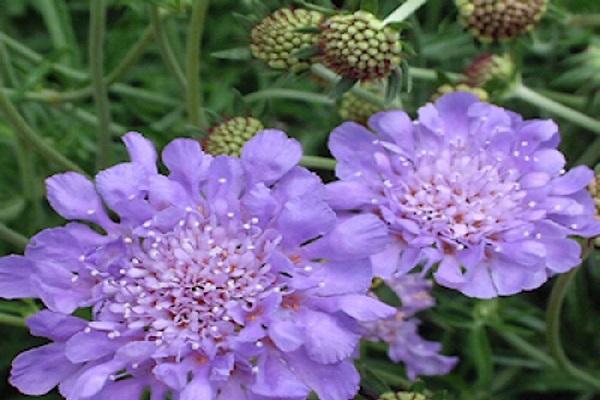
Caucasian
This type of scabiosa has a wide range of colors.There are inflorescences of lilac, red, lilac, snow-white shades. Long flowering. Flowers grow up to 8 cm in diameter. They are often chosen to decorate the garden area. The stem extends up to 76 cm.
Japanese
The stem extends up to one meter in height. Leaves are oblong with openwork edges. Inflorescences of cornflower blue or purple hue.
Olga
The height of the branched shrub is no more than 54 cm. The leaves are silvery with pubescence. Blue flowers bloom in mid-July.

Dark purple
The plant forms a bush up to 78 cm high. Flowers are double, purple, light pink or lilac. A persistent sweetish aroma emanates from the inflorescences.
Cereal
Scabiosa of this variety is distinguished by a delicate blue-white shade of inflorescences. The bush grows up to 63 cm.
Pale yellow
This type of plant reaches a height of 110 cm. The stem is erect, the flowers are light yellow in diameter up to 3.5 cm. The buds begin to open in June.
Venichnaya
The bush of scabiosa coronal is formed low, up to 55 cm. Flowers are painted in white or blue-violet color. The diameter of the head reaches 4 cm. Flowering begins in early August.
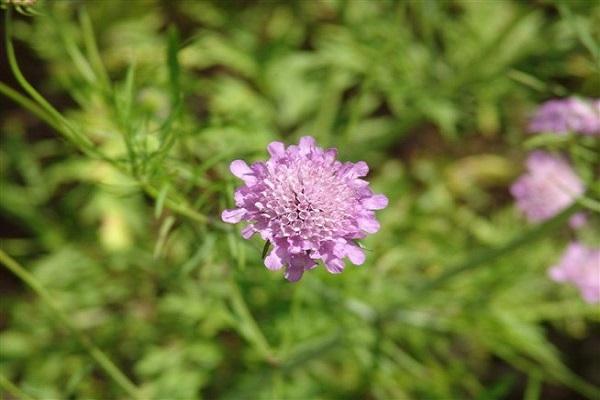
Giant
This type of scabiosa is distinguished by the large size of the head of the inflorescences. The color of the petals is light blue or blue. The buds begin to open in early June.
Popular varieties
Each scabiosa variety has its own characteristic features.
Blue Note
The height of the Blue Note variety does not exceed 19 cm. The stems are straight and branched. The flowers are dark purple in color. Abundant flowering begins in July.
Pink mist
The plant forms a bush up to 38 cm in height. Lavender or pink flowers up to 5.5 cm in diameter bloom at the end of July.
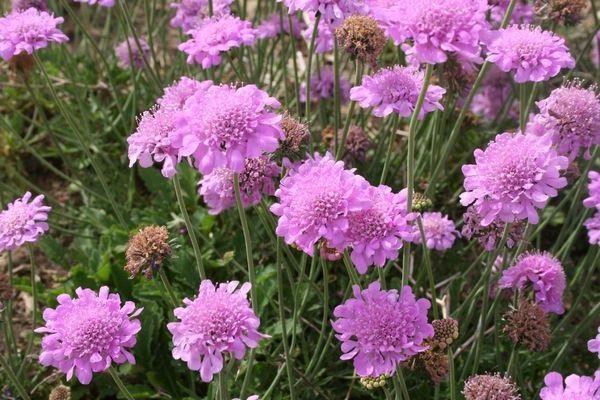
Blauer Atlas
The plant develops deep blue-violet flowers in the last days of July.
Clive greaves
Stem height 58 cm. Flowers are light lavender. Their diameter in the inflorescence reaches 7.5 cm. Flowering begins in mid-summer. Carved stem leaves.
Miss willmott
The height of the thin, strong stem is 87 cm. The flowers are snow-white or creamy.
Nachtfalter
The Night Moth variety is distinguished by bright blue or violet-blue flowers up to 6 cm in diameter.
Moerheim blue
Herbaceous perennial plant stretches up to 58 cm in height. Stems are erect, branched. On the peduncles, numerous flowers up to 5 cm in diameter, purple-blue, are formed.
Blue moon
A perennial plant forms inflorescences of a pale blue color. The height of the erect stem is up to 64 cm.
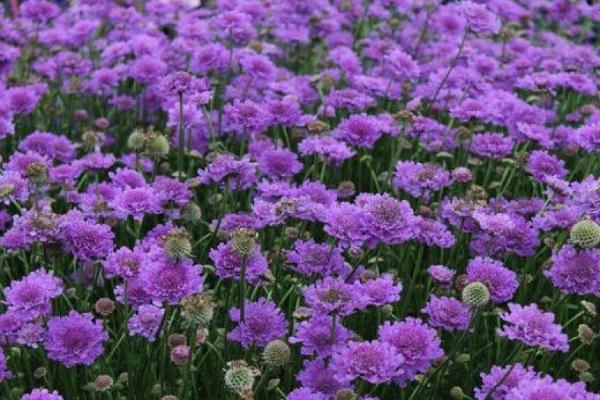
Rose cackade
The plant belongs to the dark purple variety. The inflorescences are pink in color. Flowering begins in late July.
Monarch cockade
The scabiosa variety is distinguished by large double inflorescences of various colors.
Fire king
The variety is distinguished by bright, large, fluffy red inflorescences with white small petals. The height of a straight, strong stem reaches 92 cm.
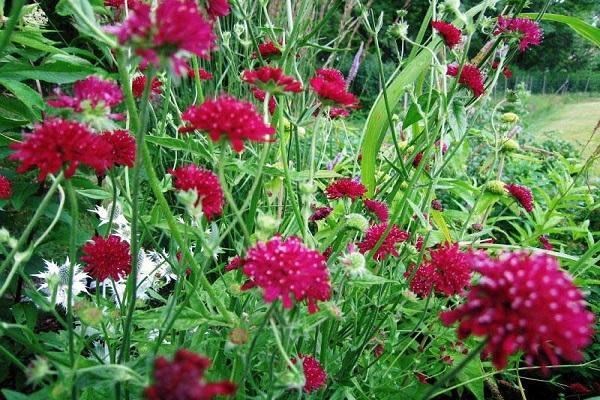
Icy heart
This variety is characterized by abundant flowering. Stems are straight, branched, 86 cm high. The inflorescences are lush, blue-white or lavender, up to 6.5 cm in diameter.
Blauer Mond
The stem of a herbaceous plant extends to a height of 58 cm. Inflorescences are dark blue.
Laheroza
The flower variety is distinguished by a compact bush 48 cm high. Inflorescences are maroon in color.
Fairy
Bushes grow small, only 24 cm. Flowers are dark blue in color.
Schneebal
The height of the stem is not more than 32 cm. The buds appear in July, the inflorescences are snow-white with a pleasant, sweet aroma.
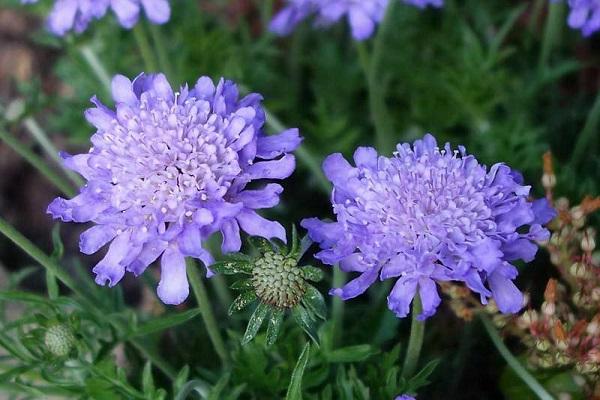
House of Isaac
The variety is distinguished by large inflorescences up to 9.5 cm in diameter, lilac-white. Flowering begins in late June.
Japanese romance
Flowers of this variety are distinguished by lilac-pink shades. The height of the slightly branched stem does not exceed 24 cm.
Butterfly blue
Compact bush (diameter up to 28 cm), low, up to 38 cm in height. Lavender-blue flowers are collected in dense capitate inflorescences. The buds begin to bloom from mid-July.
Ritz Blue
The variety is characterized by low height. The stem is straight and strong, stretches up to 22 cm. The flowers are small, violet-blue in color.
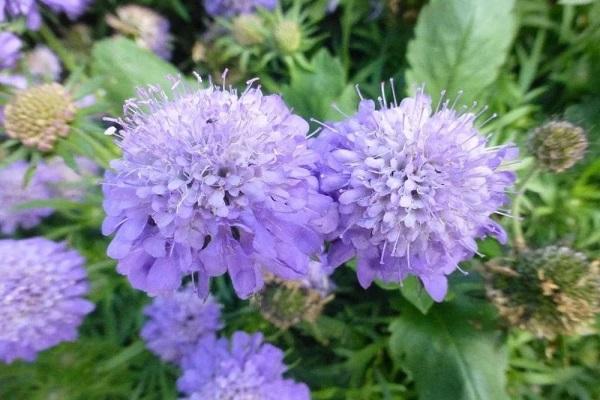
How to plant in open ground
In most cases, there are no difficulties with planting scabiosa. Maintenance is minimal and does not require a large investment of time and effort.
Seat selection
A flat area is suitable for planting a flower, which is sufficiently well illuminated by the sun and protected from through winds.
Soil requirements
Scabiosa does not take root well in heavy, clayey soils. It is best to prepare the land plot in advance. In the fall, they dig it up and bring in organic matter.
Scabiosa feels good in fertile, loose soil with good aeration and low acidity. Lime, loose soil is ideal. Too acidic soil causes the flower to wilt.
Before planting, you need to dig up the ground again and add nutrients. Liming is desirable.
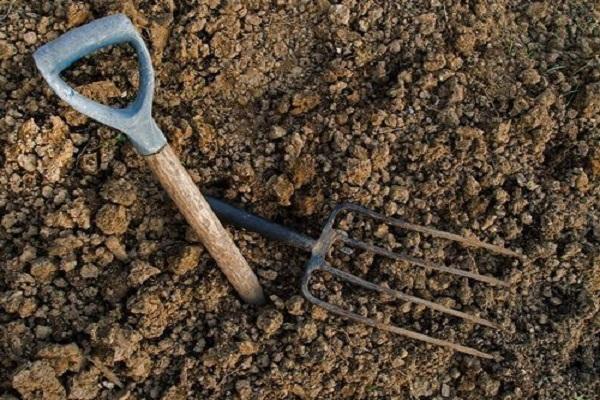
Sowing dates
Sowing seeds in an open area begins in the second half of April.
Landing scheme
In the selected area, shallow holes are made with an interval of 37 cm. Approximately 42 cm is left between the rows. After sowing the seeds, the soil is moistened and covered with a small layer of compost.
Growing through seedlings
If the climate is cold, then seedlings are chosen. Sowing in specially prepared soil begins in March.
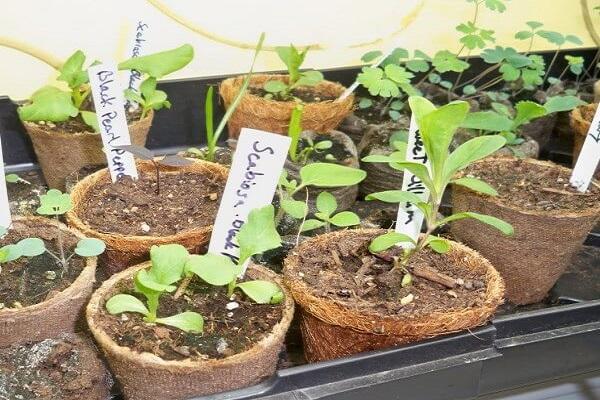
Preparation of planting material
Subject to all storage rules, the seeds retain their germination for 3-4 years:
- A stratification procedure is carried out. The seeds are hardened in a humid environment. They are immersed in sand and left in the cold for about one month.
- A selection should be made before planting. For this, a saline solution is used, in which the seeds are immersed. After 15 minutes, bad specimens, unfit for sowing, should surface. They need to be thrown away.
- Then the seeds are washed and laid out on a paper napkin.
- As soon as the planting material dries, it should be immersed in a weak solution of potassium permanganate in order to disinfect the surface.
- Many gardeners soak seeds in fungicides to protect the plant from fungal and bacterial infections. Suitable drugs such as "Fitosporin" or "Baktofit".
How to plant
You can sow seeds in large boxes or separate pots. Small depressions are made in the soil, the seeds are distributed and sprinkled on top with a layer of sand. Then there is a layer of soil again. The plantings are watered, covered with foil and removed for a week in a bright, warm place.
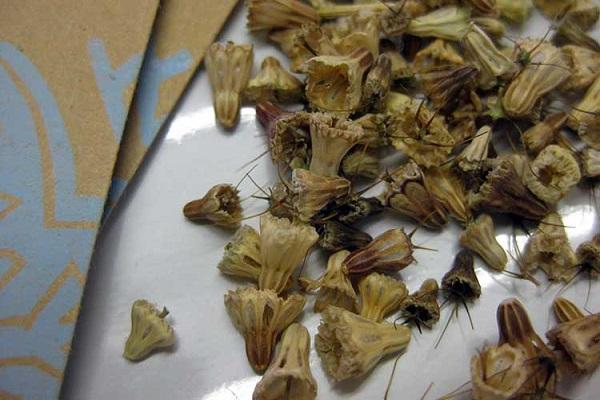
Airing
The film must be removed from the container for two hours every day. This will allow air to enter the soil and prevent rotting. It is imperative to ensure that condensation does not appear, as it causes mold on the soil. After the appearance of a larger number of seedlings, the film is removed.
Dive
As soon as the first pair of true leaves appear on the sprouts, the plant is dived into a separate container. If a common box is used, then a distance of at least 6 cm between the shoots is observed.
A week before transplanting to an open area, the seedlings begin to harden. A container with seedlings is taken outside daily. The time spent in the fresh air is increased gradually.
Landing in open ground
In the last days of May, the seedlings are transplanted into open flower beds. The soil on the site must first be dug up and fertilized. Make holes 16 mm deep at a distance of 32 cm and plant the seedlings. The first time at night it is better to cover the planting with a film.
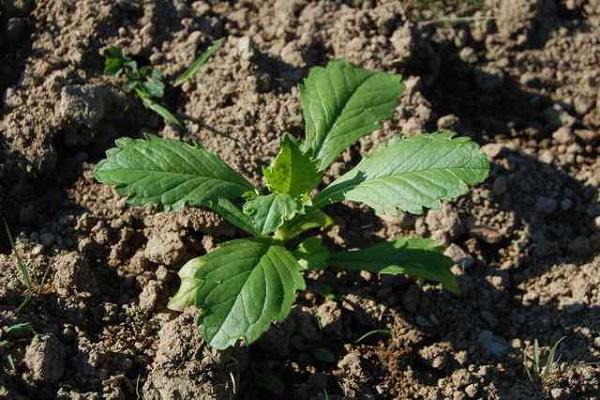
Reproduction
Reproduction of scabiosa is carried out by sowing seeds, dividing rhizomes and seedlings.
Seed
The method is suitable for reproduction of both annual and perennial flower varieties. 3 peduncles are left on the outlet until the seeds are fully ripe. Seeds are harvested in the fall and stored in cloth, cotton bags.
Sowing seeds is started in the spring, following the recommended planting scheme. The first shoots should appear after two weeks, and after 2.5 months the plant will begin to bloom.
Division of rhizomes
Some flower varieties reproduce by dividing the rhizome. As soon as the weather is warm in spring, the rhizomes are dug up, cleaned of the earth and divided into separate parts. You should act carefully so as not to damage the root branches.
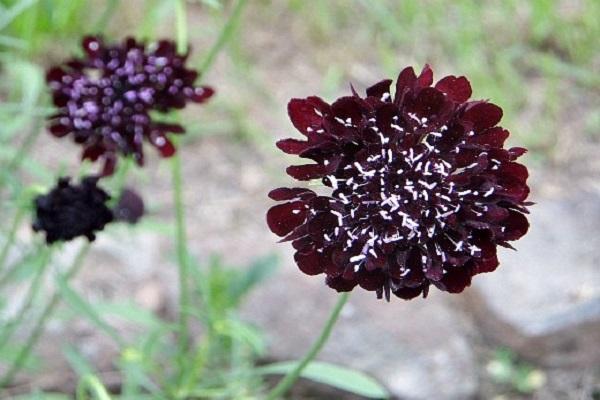
Care
The scabiosa flower is unpretentious, therefore it requires minimal maintenance. It is important to water the flower bed on time, introduce nutrients, prevent weeds from growing and carry out preventive spraying.
Watering and fertilizing
Rules to consider when watering perennial scabiosa:
- Establish regular, moderate watering.
- As soon as the topsoil becomes dry, it is necessary to start moistening. Enough once every 7 days. In dry times, the frequency of watering is increased to two times every 7 days.
- Water for irrigation is taken warm and settled.
- The procedure is best done in the morning.
The plant needs to be fed 3-4 times per season. Before the buds appear, it is recommended to apply a complex mineral fertilizer. During active flowering, formulations based on phosphorus and potassium will be useful. Fertilizer helps to increase the number of buds and rich flowers.
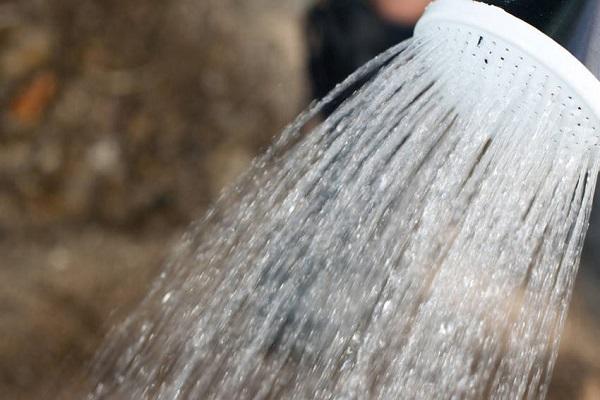
Loosening and weeding
After watering, the soil should be loosened. This will allow air and nutrients to flow freely to the roots of the plant.
Weeds must not be allowed to grow. They become the cause of the spread of diseases and pests. In addition, weeds create shade, and inflorescences form small.
Pruning
Until the very end of flowering, flower buds that have faded should be periodically cut from the bushes. Thanks to the procedure, the flowering will be lush and long-lasting. Cutting the buds is also necessary to prevent self-seeding.

Preparing for winter
With the onset of cold weather, a perennial plant should be covered with spruce branches, fallen leaves, peat or straw. In regions with a warm climate, scabiosa does not need shelter.
Collection and storage of seeds
Ripe seeds of inflorescences are easily carried by the wind, so a gauze bag is put on the peduncle. Ripe seeds are burgundy in color. The collected seeds must be thoroughly dried and placed in a cloth bag or cardboard box. Store in a cool, dry place. In such conditions, the seeds will not lose their germination for 4 years.
Diseases and pests
Scabiosa has good immunity to many diseases and is rarely attacked by insect pests. But in a rainy summer, problems can arise.
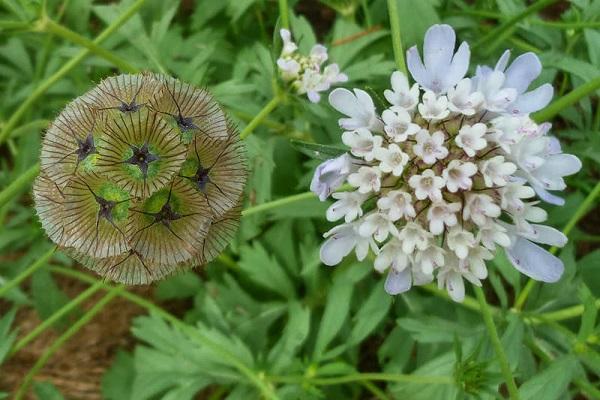
Powdery mildew
The first sign of a fungal disease is a whitish bloom on the outside of the leaf plate. The leaves gradually wither, turn yellow and fall off. The disease provokes excessive soil moisture, improper fertilization, sudden changes in air temperature, the presence of weeds and dense planting of flowers:
- In the fight against powdery mildew, chemicals such as Fundazol, Previkur, Topaz help.
- Compositions prepared according to folk recipes are considered effective. They can be based on components such as mustard, wood ash, soda, soap, garlic broth.
Root rot
In the affected plant, the stem begins to thin and darken in the root zone. After infection, the spores move to the roots of the flower. Brown spots appear on the leaves. Gradually, the leaves begin to turn yellow, wither and dry. Soon the whole flower dies.The cause of the spread of the disease is excessive soil moisture, poor-quality planting material, improper planting care:
- The fight against root rot is effectively carried out by such drugs as "Fitolavin", "Topaz", "Maxim", copper sulphate, "Gamair".
- From folk recipes, compositions based on wood ash, iodine, potassium permanganate, and milk whey are effective.
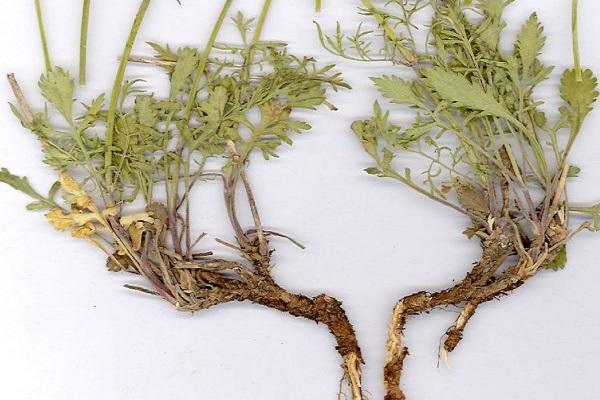
Flower moth larvae
The moth moth lays eggs on plants, from which caterpillars then emerge. They have a thin greenish or brownish glabrous body. The front pairs of legs of the caterpillar are not developed.
Insects are leaf-eating insects. As a result of their activity, the plant weakens, and its resistance to cold and infections decreases.
The following methods will help in the fight against the pest:
- treatment with chemicals: "Akarin", "Fitoverm", "Karbofos", "Bitoxibacillin";
- the use of folk recipes: decoctions of tomato tops, burdock, hot pepper.
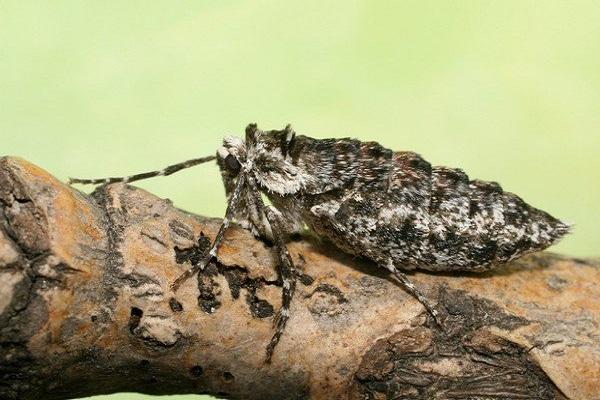
Vole mice
Vole mice can harm plants. The length of their body is approximately 11 cm, the length of the tail is 4 cm. The fur is gray. Rodents eat flower stems.
Pest control methods:
- setting traps, traps;
- the use of chemical, poisonous drugs;
Use in landscape design
Scabiosa will adorn alpine slides and any other flower beds. Looks nice along paths and curbs.
How is it used in floristry
Scabiosa is used to create unusual bouquets for any festive occasion. Cut inflorescences do not lose their fresh appearance and aroma for 6 days. Scabiosa goes well with other colors.

